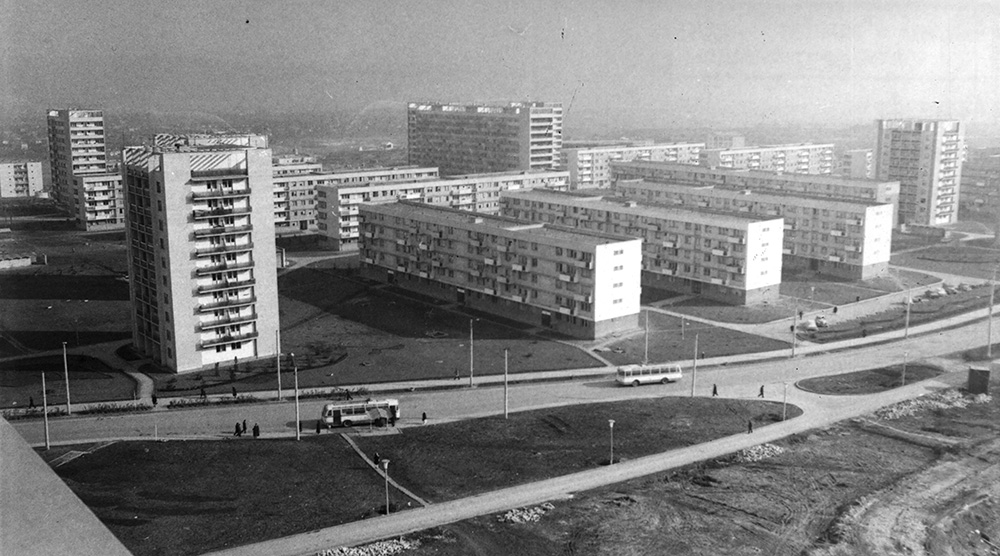Gheorgheni Housing Estate in Cluj
Additional Files
DOI:
https://doi.org/10.52200/docomomo.68.04Keywords:
modernism, functionalist city, socialist housing, 1960s, RomaniaAbstract
The paper addresses the Gheorgheni housing estate in Cluj (1964-1969) as a remarkably well-preserved example, representative of a particular phase in the evolution of socialist housing in Romania. It argues, in the context of the present debates on the notion of postwar modernism, that Gheorgheni is a proper modernist example and that this specific period in the history of Romanian socialist housing can be defined as the modernist period. This was a time when the state set up a housing production system adapted to mass scale at the national level, and when the first large housing estates emerged. A young generation of architects working in the newly created regional design institutes eagerly embraced modern architecture, in both its aesthetic and social dimension. Through an analysis based on interviews with architects, photographic archival material, publications of the time, and references to contemporary debates on postwar modernism, the paper identifies the sources that informed the Gheorgheni project and shows how it embodied the model of modernist housing in its "ideal" form – i.e., close to the classical functionalist model of modern architecture and urbanism. It demonstrates the consistency of its modernist project and claims that the coherent urban and architectural design, together with the social mixing of its residents, account for its success over time. Unlike other estates from the same period, it has suffered only minimal later interventions and it is still a desirable residential area today. Eventually, the objective is to make the case for the listing of the estate as a modern architectural and urban heritage monument that deserves preservation, despite the negative undifferentiating perception of postwar housing that persists in Romania today.How to Cite
Published
Issue
Section
License
Copyright (c) 2023 Dana Vais

This work is licensed under a Creative Commons Attribution 4.0 International License.
Plaudit
References
ANSAMBLUL de locuințe microraion 1 din cartierul Gheorgheni -Cluj (1967) [The Housing ensemble microraion 1 ofGheorgheni estate - Cluj]. In Arhitectura XV(2), 24-25.
BUZULOIU, A. (2023). Interview with the author, January 10.
CAN, B., MAXIM, J. (2022). Introduction. In. Can, B, Maxim, J.(eds.) Architecture and the Housing Question (pp. 1-17),Routledge. DOI: 10.4324/9781351182966-1 DOI: https://doi.org/10.4324/9781351182966-1
CHIȚULESCU, T. et.al. (Eds) (1958). Manualul Arhitectului Proiectant [Practicing Architect Handbook]. București: Ed.Tehnică. vol.III. (In Romanian)
COHEN, J.L. (2009). Modernism and Periphery [video file posted November 2010], http://www.recentering-periphery.org/jean-louis-cohen-modernism-and-periphery/ Accessed Dec. 25, 2022.
COHEN, J.-L. (2012). The Future of Architecture Since 1889. Phaidon.
COHEN, J.-L. (2021). Jean Louis Cohen and the Transurbanism of the Modern City [audio file, August 26, 2021], Architecture Talk, https://www.architecturetalk.org/home/111 Accessed Jan. 11, 2023.
DAS ERSTE Programm für einen Internationalen Kongress für Neues Bauten (1979 [1928]) [The First program for an International Congress of New Building]. In Martin Steinmann (ed.) (1979) CIAM. Internationale Kongresse für Neues Bauen. Dokumente 1928-1939. Basel: Birkhaüser (pp.12-13) (In German and French)
DREMAITE, M. (2017). Baltic Modernism: Architecture and Housing in Soviet Lithuania, DOM Publishers.
FORTY, A. (2000). Words and Buildings. A Vocabulary of Modern Architecture. Thames & Hudson.
GONOS, St. (1973). Realizări clujene [Realizations in Cluj], Arhitectura XXI(2), 38-40. (In Romanian)
HITCHCHOCK, H.-R. (1932). Richard J. Neutra. In Modern Architecture International Exhibition. New York: Museum of Modern Art (pp.157-170).
JOHNSON, Ph. (1932). Historical Note. In Modern Architecture International Exhibition. New York: Museum of Modern Art (pp.18-20).
LAURIAN, R. (1954). Spații libere plantate în orașul socialist [Open green spaces in the socialist city]. In Arhitectura RPR (1), 16-24. (In Romanian)
LE CORBUSIER (1935) La Ville Radieuse [The Radiant City], Paris: Éditions de l’Architecture d’Aujourd’hui. (In French)
LE CORBUSIER (1971). Bucuriile esențiale. Texte alese [Essential Joys. Selected texts], Anthology and translation by M. Melicson, Bucharest: Meridiane. (In Romanian)
LE CORBUSIER (1979 [1937]), Rapport no.1. / 5.Kongress, Wohnung und Erholung, Paris [Report no.1. / 5th Congress, Habitation and Leisure]. In Martin Steinmann (ed.) (1979) CIAM. Internationale Kongresse für Neues Bauen. Dokumente 1928-1939. Basel: Birkhaüser (pp.182-189). (In German and French)
MARIAN, L., MITREA, V. (2021). Urbanism și urbaniști din Cluj [Urbanism and urbanists of Cluj]. Academia Română. (In Romanian)
MELICSON, M. (1975). Arhitectura modernă [Modern Architecture]. Bucharest: Ed. Științifică și Enciclopedică. (In Romanian)
MITREA, V. et al., (2011). Cluj-Napoca în proiecte 50 de ani 1960-2010 [Cluj-Napoca in projects 50 years 1960-2010], Imprimeria Ardealul. (In Romanian)
MITREA, V. (2023). Interview with the author, January 7.
MOLNÁR, V. (2005). Cultural Politics and Modernist Architecture. The Tulip Debate in Postwar Hungary. In American Sociological Review 70, 111-135. DOI: https://doi.org/10.1177/000312240507000106
MUMFORD, E. (2019). CIAM and Its Outcomes. In Urban Planning, 4(3), 291-298. https://doi.org/10.17645/up.v4i3.2383 Accessed Dec. 27, 2022. DOI: https://doi.org/10.17645/up.v4i3.2383
MUMFORD, L. (1932). Housing. In Modern Architecture International Exhibition. New York: Museum of Modern Art (pp.179-189).
PUGH, E. (2015). From “National Style” to “Rationalized Construction”. Mass Produced Housing, Style and Architectural Discourse in the East German Journal Deutsche Architektur 1956-1964. In Journal of the Society of Architectural Historians, 76(1), 87-108. DOI: https://doi.org/10.1525/jsah.2015.74.1.87
REID, S. (2006). Khrushchev Modern. Agency and Modernization in the Soviet Home. In Cahier du Monde Russe 47 (1-2), 227-268. DOI: https://doi.org/10.4000/monderusse.3800
RUSU, D., S. Varenic, A. Trandafiropol (2018). Socialist Modernist Architecture. Romania and the Republic of Moldova, 1955-1989. Architectural guide, BACU. (In Romanian and English)
SEBESTYEN, V. (1962). Proiectarea microraioanelor [Microraions design]. In Arhitectura RPR X(2), 11-14. (In Romanian)
VAIS, D. (2022). Systematization: A Key Term in 20th-Century Romanian Urbanism. In Urban Planning 7(1), 207-222. DOI: https://doi.org/10.17645/up.v7i1.4791
VIDLER, A. (2008). Histories of the Immediate Present. Inventing Architectural Modernism, MIT Press, Cambridge Mass. DOI: https://doi.org/10.7551/mitpress/7699.001.0001
ZAHARIADE, A.M. (2012). Architecture in the Communist Project. Romania 1944-1989, Simetria. (In Romanian and English)





